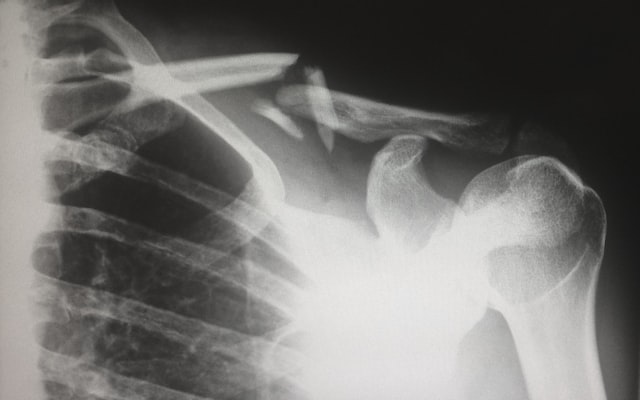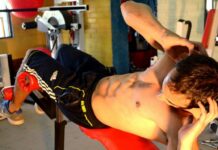When receiving body massages, you surely agree with me that one of the areas where tension is released the most is definitely the shoulders. In these and in the back the stress of the day to day, of the intense days of work, the hectic days at home and also the lack of exercise tend to accumulate. Even training daily, many forget to exercise areas as important as the shoulders, especially women who tend to give more importance to the lower muscles.

In the shoulders are fundamental muscles and joints on which other areas of the back, arms and chest depend. That is why exercising the shoulders properly become a key part during training, especially for the upper part of the body.
The shoulders can be exercised through ordinary push-ups, popularly known as push-ups. However, if your goal is to improve your muscles and strength in a more focused way; in this article we present the necessary keys to achieve it.
Why exercise the shoulders?
This area of the arms, in addition to being one of the areas of the body that accumulates the most tension, even for years, the shoulders are an important part of the posture. Shoulder flexion’s make it easier to maintain a straight and upright posture, not only on a day-to-day basis, but also when performing other exercises.
Many of the arm injuries such as dislocations, tendinitis, bursitis, among others, arise as a result of overloading or lack of exercise in the shoulders. Training this part of the body will allow you to perform a more complex training and with a greater amount of weight, which will make it easier for your shoulders to acquire greater muscle mass and strength, basic objectives of many men who train.
For women it is also an area that should be worked on, perhaps in a basic way avoiding large amounts of weight, unless you prefer more specialized training.
How to do shoulder push-ups?
Although with ordinary push-ups you can exercise the shoulders just the same. There are other types of exercises that are specifically focused on the shoulders and therefore work the shoulder joints with greater emphasis.
The proper position to perform this type of push-up is based on maintaining the correct posture, paying more attention to the upper part of the body. With your arms resting on the ground, your head should be between them. With our feet slightly inclined and our knees extended, we flex our arms and try to touch the ground with our heads.
It is an exercise that depends a lot on the flexibility of your arms and legs, so we recommend that you warm up and stretch your muscles well before starting the push-ups. This is one of the exercises that prepare you for another, considered one of the most complexes: the handstand, a type of push-up in which you can work many parts of the body.
This is the basic shoulder flexion; however there are many other variations of the exercise and others that are supported by weights or other tools that contribute to making the exercise even more complex.
Bench shoulder push-ups
With this exercise you can work the back of the shoulders and strengthen the triceps. It is a variant of the traditional parallel bars, which is why they require a higher level of knowledge and practice.
On your back, place your hands on the edge of the bench, wider than shoulder-width apart. You must keep your feet flat on the ground, so that they work as a point of support, although they must remain relaxed to allow the upward and downward movement of the body. The movement must be carried out in such a way that the back touches the bench on each rise, as well as on the descent.
Lateral shoulder flexion’s
This exercise is performed by supporting one of the arms on the ground, by the elbow and the forearm. The opposite hand should be supported on the legs, which will remain straight and together.
It’s just staying in this position, tensing the muscles of the body for as long as you can, especially those of the arms and abdomen, that in this type of exercise it is necessary to work them.
Barbell shoulder curls
The bars, whether with weight or not, have always been great allies in different exercises, in the case of push-ups they work as a gripping tool in many different ways. In this exercise in question, it is necessary to use a bar that is at a medium height, you can use your own dimensions to measure it.
The first step is to grab the bar by positioning yourself with your back facing the ground. In a horizontal position, slightly bend your knees, resting your feet on the floor. If you don’t have a bar or when you do the exercise at home, you can use a wooden table that supports your body weight.
Double height push-ups
Taking into account the technique of ordinary push-ups, also known as push-ups, this type of push-up constitutes a variant of them. You must support your hands on the ground as if you were doing a traditional push-up, but your feet will be supported on a surface slightly higher than the ground.
Variations of ordinary push-ups also work to exercise the shoulder area, as well as the muscles and joints associated with it. In this sense, the height of the surface where your feet will be supported will mark the level of difficulty and complexity of the exercise. The higher it is the weight on your shoulders increases and this region of the arms will be worked with greater intensity.
Clap push-ups, one-arm push-ups, and lateral push-ups are also exercises you can do to work out your shoulders. By adding weight to your back as you progress in training, you will increase the level of difficulty in the exercise and will facilitate the increase in muscle mass in this area, as well as its strength.
Vertical shoulder flexion’s
Do you remember the bottom of the pine? Well, this type of push-up is considered one of its variants, although you need a support wall to maintain your balance. The starting position for this exercise is as follows:
Place your hands on the ground and with your back to the wall, support your feet on it. From this position, flex your arms as far as you can and you will notice the load on your shoulders and how they are exercised in depth.
Shoulder workout with dumbbells
As explained above, one way to increase the level of difficulty, when you notice that your training is being rather light, because your body could withstand higher levels of intensity, is precisely to incorporate weight tools into the exercises you perform. In this sense, dumbbells are one of the most popular instruments in many workouts, especially to exercise the arms and upper body.
For this reason, we propose a series of exercises for shoulders with dumbbells, which you can do once you get past the amateur phase of training.
Lateral raises
This exercise can be done standing or sitting on a bench, the important thing in any position is to maintain an upright posture, with a straight back and tight muscles. Again, work on the abdominal area and control of breathing is necessary.
Hold the dumbbells with your palms facing inward, starting from the starting position, where your hands would be by your sides. Raise your arms to chin height and repeat several times. The weight of the dumbbells and the repetitions you perform will depend on the level you are at, in relation to training.
A variant of this exercise consists of slightly bending your arms, using the dumbbells and bringing them together in such a way that they brush in front of your face. With this variant, the muscles of the back and chest are also exercised.
Lying Lateral Raises
This is a variant of the previous exercise, although this one works only one shoulder at a time. You should lie on your side on a mat, supporting your head on one of your arms as if you were going to take a nap.
With the other arm you must perform the elevations with the dumbbell. Try to alternate between one repetition and another so that both arms are exercised during the exercise.
Front shoulder raises
In this exercise we will raise the dumbbells with the arms, but these will be placed in front of the body. Likewise, the palms should go down, parallel to the ground. To exercise the shoulders in depth, the elevations should not exceed the height of the shoulders.
Shoulder exercises with TRX
No, it is not a rare medical device. TRX consists of a military technique that has been incorporated into physical training, in which we use an elastic belt to perform a certain exercise.
Training with this tool contributes to the development of functional strength, which is nothing more than that based on natural motor movements that are part of the functioning of our body. Likewise, working with these elastic bands contributes to improving the flexibility and balance of the central part of the body.
These tools can be found at different sporting goods outlets or at the gym we usually go too regularly.
Shoulder flexion’s on the back with TRX
With your back to the wall where the TRXs are attached, take them with your hands and lean forward keeping your legs slightly bent but without taking your feet off the ground. Flex your arms through slow repetitions so that all the muscles involved are exercised.
Facing the wall where the TRXs are attached, you will be performing a variant of this exercise.
You can do other similar exercises with elastic bands that don’t need to be attached to any surface. The grip points that will facilitate the tension of these strips can be precisely your hands or your feet.
One of these exercises consists of stepping on the middle of the band with your feet, taking the ends of it with your hands and performing lateral or frontal elevations. It is an exercise similar to the one we proposed earlier with dumbbells.
If you finally take into account some of these exercises to incorporate them into your weekly training, we recommend that you do not perform other routines that involve the shoulders, to ensure that the specific training is efficient, since otherwise you would be loading this area excessively.
To advance in physical training, it is important to plan and take into account compliance with the routines you perform.
You can keep track of the increase or decrease in repetitions and the weight you load, as it will allow you to achieve greater efficiency in your training. All this helps to verify the advances and setbacks that you can have week after week and depending on it, add or not add complexity to your routines.
















